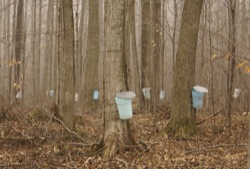 |
TreeTapper Tools to better understand biology by tapping information in phylogenies |
Not logged in |
Here will be basic tutorials: how to get a tree, why branch lengths matter, etc.
How do I get a tree?
One relevant concern is what kind of tree you need. Some methods (often parsimony-based) for looking at character evolution just need a topology -- a tree without branch lengths. For that, TreeBase might suffice. TreeBase is a repository of topologies (branch lengths are not allowed in submitted trees), often with data included (so, it's possible to get, for example, parsimony-based branch lengths by bringing the tree and data into a program like PAUP). There are some alternate interfaces to TreeBase: Phylofinder by Duhong Chen allows more flexible searches, but doesn't yet allow downloads of the nexus files; TBMap by Rod Page allows matching of taxon names in TreeBase to other names. San Diego Supercomputer Center had a mirror of TreeBase with a different interface, but it is no longer working.
For most character methods (independent contrasts, various likelihood/Bayesian methods for looking at rates of character evolution, etc.), a tree with branch lengths , often proportional to time, is needed. There is currently no place to download such trees. A recent paper on a group of interest may have a calibrated tree to download as supplementary info. For plants, the Phylomatic site allows download of a tree with branch lengths. Making a tree oneself is also a good option. TreeBase allows data sets to be downloaded; raw sequence data may also be pulled from GenBank. The Phylota browser has organized GenBank info by taxon, so one can find aligned gene datasets for a given named group of taxa to analyze. Tree building itself can be done with a wide variety of programs (see Felsenstein's list of likelihood/Bayesian tree inference programs); there are also online servers for tree search, including the CIPRES tree portal. For calibrating a tree (using fossil or other information to make branches proportional to time), popular programs are BEAST, r8s, and MultiDivTime. Note that some methods need trees that are fully resolved (no polytomies: nodes with more than two descendants); others, especially those dealing with speciation and extinction, require trees with ALL extant species sampled.
How do I get a tree?
One relevant concern is what kind of tree you need. Some methods (often parsimony-based) for looking at character evolution just need a topology -- a tree without branch lengths. For that, TreeBase might suffice. TreeBase is a repository of topologies (branch lengths are not allowed in submitted trees), often with data included (so, it's possible to get, for example, parsimony-based branch lengths by bringing the tree and data into a program like PAUP). There are some alternate interfaces to TreeBase: Phylofinder by Duhong Chen allows more flexible searches, but doesn't yet allow downloads of the nexus files; TBMap by Rod Page allows matching of taxon names in TreeBase to other names. San Diego Supercomputer Center had a mirror of TreeBase with a different interface, but it is no longer working.
For most character methods (independent contrasts, various likelihood/Bayesian methods for looking at rates of character evolution, etc.), a tree with branch lengths , often proportional to time, is needed. There is currently no place to download such trees. A recent paper on a group of interest may have a calibrated tree to download as supplementary info. For plants, the Phylomatic site allows download of a tree with branch lengths. Making a tree oneself is also a good option. TreeBase allows data sets to be downloaded; raw sequence data may also be pulled from GenBank. The Phylota browser has organized GenBank info by taxon, so one can find aligned gene datasets for a given named group of taxa to analyze. Tree building itself can be done with a wide variety of programs (see Felsenstein's list of likelihood/Bayesian tree inference programs); there are also online servers for tree search, including the CIPRES tree portal. For calibrating a tree (using fossil or other information to make branches proportional to time), popular programs are BEAST, r8s, and MultiDivTime. Note that some methods need trees that are fully resolved (no polytomies: nodes with more than two descendants); others, especially those dealing with speciation and extinction, require trees with ALL extant species sampled.